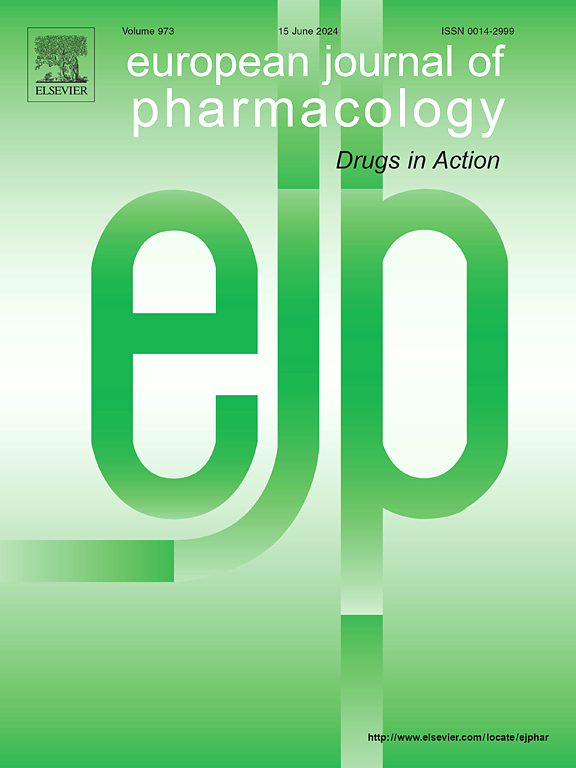肌肽通过大鼠脑组胺H1受体、基底前脑胆碱能神经元、腺苷A2B受体和迷走神经改善结肠高通透性。
IF 4.2
3区 医学
Q1 PHARMACOLOGY & PHARMACY
引用次数: 0
摘要
肠漏与肠易激综合征(IBS)和阿尔茨海默病(AD)等疾病有关。我们之前的研究表明,脑组胺H1受体通过基底前脑胆碱能神经元(BFCNs)、腺苷A2B受体和迷走神经介导的信号传导调节肠道屏障功能。在这项研究中,我们研究了肌肽(一种由-丙氨酸和l -组氨酸组成的二肽)在调节肠道屏障完整性中的作用。在lps诱导的漏肠大鼠模型中,通过Evans蓝染色法测定,腹腔内给药肌肽可改善结肠通透性。脑H1受体拮抗剂、迷走神经切断术和BFCNs或腺苷A2B信号的抑制可消除这种作用,表明肌肽通过这些中枢通路起作用。同样,腹腔注射大剂量肌肽可缓解结肠高通透性,但其作用也被相同的干预措施所阻断。此外,运动还能降低脂多糖诱导的高渗透性,这种效应被脑组胺H1受体阻断所消除。这些发现表明,外周肌肽,包括肌肉来源的肌肽,有助于肠屏障的中枢调节。增强屏障完整性,减少内脏过敏,表明肌肽可能是肠易激综合征的有效治疗方法。此外,在肌肉减少症中观察到肌肉肌肽的下降,加上痴呆风险的增加,支持其治疗AD的潜力。总的来说,目前的研究强调了肌肽和肌肉源性策略在管理漏肠相关疾病方面的前景。本文章由计算机程序翻译,如有差异,请以英文原文为准。
Carnosine improves colonic hyperpermeability through the brain histamine H1 receptor, basal forebrain cholinergic neurons, adenosine A2B receptors and vagus nerve in rats
Leaky gut is implicated in disorders such as irritable bowel syndrome (IBS) and Alzheimer's disease (AD). Our previous study demonstrated that brain histamine H1 receptor signaling—mediated via basal forebrain cholinergic neurons (BFCNs), adenosine A2B receptors, and the vagus nerve—regulates intestinal barrier function. In this study, we investigated the role of carnosine, a dipeptide composed of beta-alanine and L-histidine, in modulating intestinal barrier integrity. In an LPS-induced leaky gut rat model, intracisternal administration of carnosine improved colonic permeability as determined by the Evans blue dye method. This effect was abolished by brain H1 receptor antagonism, vagotomy, and inhibition of either BFCNs or adenosine A2B signaling, suggesting that carnosine acts via these central pathways. Similarly, high-dose intraperitoneal carnosine alleviated colonic hyperpermeability, with its effect also blocked by the same interventions. Additionally, exercise reduced LPS-induced hyperpermeability—an effect eliminated by brain histamine H1 receptor blockade. These findings indicate that peripheral carnosine, including muscle-derived carnosine, contributes to the central regulation of the intestinal barrier. Enhanced barrier integrity, which reduces visceral hypersensitivity, suggests that carnosine may be an effective therapeutic for IBS. Moreover, the decline in muscle carnosine observed in sarcopenia, coupled with an increased dementia risk, supports its therapeutic potential for AD. Collectively, the present study underscores the promise of carnosine and muscle-derived strategies in managing leaky gut-related disorders.
求助全文
通过发布文献求助,成功后即可免费获取论文全文。
去求助
来源期刊
CiteScore
9.00
自引率
0.00%
发文量
572
审稿时长
34 days
期刊介绍:
The European Journal of Pharmacology publishes research papers covering all aspects of experimental pharmacology with focus on the mechanism of action of structurally identified compounds affecting biological systems.
The scope includes:
Behavioural pharmacology
Neuropharmacology and analgesia
Cardiovascular pharmacology
Pulmonary, gastrointestinal and urogenital pharmacology
Endocrine pharmacology
Immunopharmacology and inflammation
Molecular and cellular pharmacology
Regenerative pharmacology
Biologicals and biotherapeutics
Translational pharmacology
Nutriceutical pharmacology.

 求助内容:
求助内容: 应助结果提醒方式:
应助结果提醒方式:


